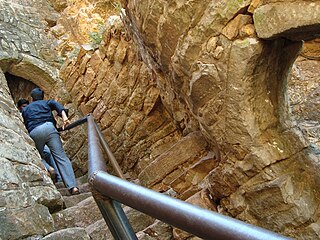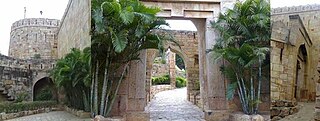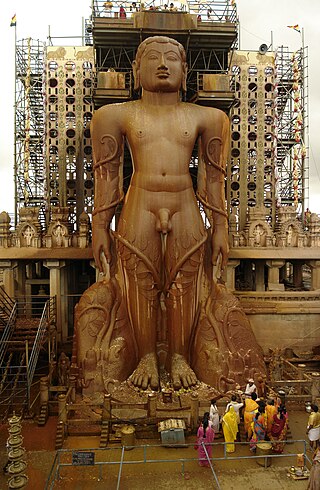
Belgaum, officially known as Belagavi, is a city in the Indian state of Karnataka located in its northern part along the Western Ghats. It is the administrative headquarters of the eponymous Belagavi division and Belagavi district. The Government of Karnataka has proposed making Belgaum the second capital of Karnataka alongside Bangalore, hence a second state administrative building Suvarna Vidhana Soudha was inaugurated on 11 October 2012.

Bijapur is the district headquarters of Bijapur district of the Karnataka state of India. It is also the headquarters for Bijapur Taluk. Bijapur city is well known for its historical monuments of architectural importance built during the rule of the Adil Shahi dynasty. It is also well known for the popular Karnataka premier league team, the Bijapur Bulls. Bijapur is located 519 km (322 mi) northwest of the state capital Bangalore and about 550 km (340 mi) from Mumbai and 210 km (130 mi) north east of the city of Belgaum.

Belagavi district, formerly also known as Belgaum district, is a district in the state of Karnataka, India. The district is known as the sugar bowl of Karnataka with 150,000 hectares being used for commercial production. It has overtaken Mandya district in sugarcane production over the last decade. The city of Belgaum (Belagavi) is the district headquarters in Belagavi district. It houses the Second legislative building, where the Karnataka Legislature holds session once a year. The district is famous for its native sweet, Kunda. According to the 2011 Census of India, it has a population of 4,779,661, of which 24.03% live in urban areas, making it the second most populous district in Karnataka, after Bangalore Urban. The district has an area of 13,415 km2 (5,180 sq mi), making it the largest district in terms of size in Karnataka It is bounded by Kolhapur District and Sangli district of Maharashtra state on the west and north, on the northeast by Bijapur district, on the east by Bagalkot district, on the southeast by Gadag district, on the south by Dharwad and Uttara Kannada districts, and on the southwest by the state of Goa.

Gokak is a taluka headquarters in the Belagavi district of Karnataka state, India. It is located around 70 km from Belagavi at the confluence of the Ghataprabha and Markandeya rivers. The population of the city is 79,121, according to the 2011 census. Gokak city has the second highest GDP in the district of Belagavi after Belagavi city. Kannada is the commonly spoken language.

Gingee Fort or Senji Fort in Tamil Nadu, India is one of the surviving forts in Tamil Nadu, India. It lies in Villupuram District, 160 kilometres (99 mi) from the state capital, Chennai, and is close to the Union Territory of Puducherry. The site is so fortified that Chhatrapati Shivaji Maharaj, the Maratha king, ranked it as the "most impregnable fortress in India", and it was called the "Troy of the East" by the British. The nearest town with a railway station is Tindivanam and the nearest airport is Chennai (Madras), located 150 kilometres (93 mi) away.

Rashtrakuta was a royal Indian dynasty ruling large parts of the Indian subcontinent between the 6th and 10th centuries. The earliest known Rashtrakuta inscription is a 7th-century copper plate grant detailing their rule from Manapur, a city in Central or West India. Other ruling Rashtrakuta clans from the same period mentioned in inscriptions were the kings of Achalapur and the rulers of Kannauj. Several controversies exist regarding the origin of these early Rashtrakutas, their native homeland and their language.

Parasgad Fort is a ruined hill fort in the Belgaum district of Karnataka state, India. magnificent fort of Parashghad, dating back to the 10th century and built by famous rulers of Ratta dynasty. Parasgad Fort is located about two kilometres south of Saundatti village, and stands on the south-west edge of a range of hills immediately overlooking the black soil plain down below.

Savadatti is one of the oldest towns in Belagavi district in the Indian state of Karnataka. It is a celebrated Hindu pilgrimage centre located 78 kilometres from Belagavi and 41 kilometres from Dharwad. Savadatti is also the name of the taluk (sub-district), which was previously named Parasgad. There are several ancient temples in Savadatti.

North Karnataka is a geographical region in Deccan plateau from 300 to 730 metres elevation that constitutes the region of the Karnataka state in India and the region consists of 14 districts. It is drained by the Krishna River and its tributaries the Bhima, Ghataprabha, Malaprabha, and Tungabhadra. North Karnataka lies within the Deccan thorn scrub forests ecoregion, which extends north into eastern Maharashtra.

Tailapa II, also known as Taila II and by his title Ahavamalla, was the founder of the Western Chalukya Empire in peninsular India. Tailapa claimed descent from the earlier imperial Chalukyas of Vatapi (Badami), and initially ruled as a Rashtrakuta vassal from the Tardavadi-1000 province in the present-day Vijayapura district of Karnataka. When the Rashtrakuta power declined following an invasion by the Paramara king Siyaka, Tailapa overthrew the Rashtrakuta emperor Karka II, and established a new dynasty.
Bankapura is a panchayat town in Haveri district in the state of Karnataka, India. It is in Shiggaon taluk, is just 2.5 km from the Pune-Bangalore national highway NH-4, 22 km from Haveri town. Bankapura is about 45 km from Hubli-Dharwad. An historical site, Bankapura is famous for the Nagareshwara temple, Bankapura fort, The Bankapura Peacock Sanctuary. Baada, the birthplace of Kanakadasa is near to Bankapura.
Yellur is a village and Gram panchayat in the Belagavi district, state of Karnataka, India. It is situated at the foot of a small hillock locally called Yellurgad, 6 km (3.7 mi) to the south of the city of Belagavi. It is a village with multiple temples dedicated to Brahmalling, Kalmeshwar, Lakshmi, Dattatreya, Parameshwara, Hanuman and Changaleshwari. The jatra in honour of the goddess is held during Chaitra, when about 20,000 people participate.

Karnataka, the sixth largest state in India, has been ranked as the third most popular state in the country for tourism in 2014. It is home to 507 of the 3600 centrally protected monuments in India, second only to Uttar Pradesh. The State Directorate of Archaeology and Museums protects an additional 752 monuments and another 25,000 monuments are yet to receive protection.

The History of Karnataka goes back several millennia. Several great empires and dynasties have ruled over Karnataka and have contributed greatly to the history, culture and development of Karnataka as well as the entire Indian subcontinent. The Chindaka Nagas of central India Gangas, Rashtrakutas of Manyakheta, Chalukyas of Vengi, Yadava Dynasty of Devagiri were all of Kannada origin who later took to encouraging local languages.
Several branches of the Rashtrakuta dynasty were created by the kings, commanders and relatives of the Rashtrakuta family during their expansion into central and northern India in the eighth to the tenth centuries. These kingdoms ruled during the reign of the parent empire or continued to rule for centuries after its fall or came to power much later. Well known among these were the Rashtrakutas of Lata (757–888), the Rattas of Saundatti (875–1230) in modern day Karnataka, the Rashtrakutas of Rajasthan and ruling from Hastikundi or Hathundi (893–996), Dahal, the Rathores of Mandore and Dhanop, Reddy dynasty of Andhra Pradesh and Telangana, Rashtraudha dynasty of Mayuragiri in modern day Maharashtra and Rashtrakutas of Kanauj.

Belgaum Fort is in the city of Belgaum, in the Belgaum district, in Karnataka state, India. It was begun by Jaya Raya, also called Bichi Raja, an ally of the Ratta Dynasty, in the year 1204. It has undergone several renovations over the centuries under dynastic rulers of the region.

The following outline is provided as an overview of and topical guide to Karnataka:

The Savadatti Fort, also known as Saundatti Fort located in the western part of Savadatti town in the Indian state of Karnataka is an irregular shaped military structure built in the 18th century over a small hill. A smaller fort within the main fort houses the Kadasiddheshwara temple.














